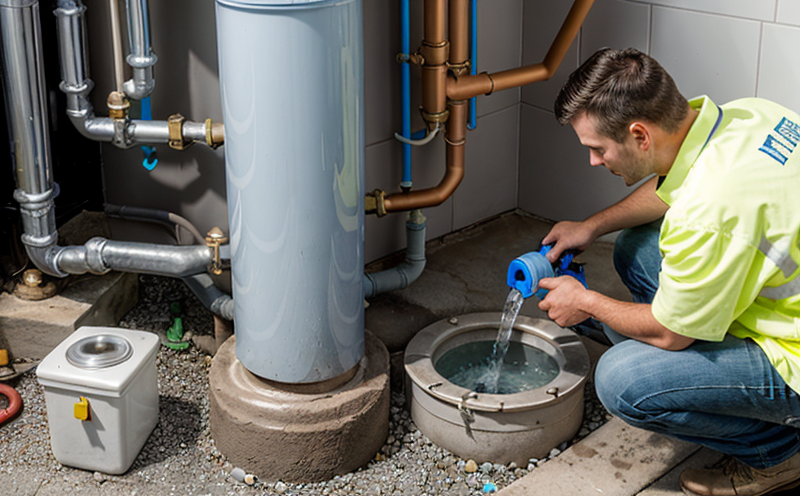EN 806-5 Maintenance Testing of Water Systems
The European standard EN 806-5 specifies the requirements and procedures for the maintenance testing of water systems. This comprehensive test is essential for ensuring the long-term reliability, safety, and efficiency of plumbing installations in buildings and infrastructure projects.
EN 806-5 covers a wide range of aspects related to water system maintenance, including but not limited to, pressure tests, leakage detection, flow rate checks, and microbiological testing. The standard aims to provide a framework for regular inspections and preventive measures that help identify potential issues before they lead to costly repairs or failures.
Regular maintenance is critical in plumbing systems as it helps extend the life of the infrastructure by identifying and addressing minor problems early on. By following the guidelines set forth in EN 806-5, organizations can ensure compliance with regulatory requirements while also improving overall performance and reducing downtime.
The process typically involves a series of steps designed to assess various components of the water system. These include visual inspections, pressure testing at different points within the network, checking for leaks or blockages, monitoring flow rates, and conducting microbiological assessments.
For instance, during a pressure test, technicians will apply a controlled amount of pressure to specific sections of the piping system and monitor for any signs of leakage. Leakage detection is crucial because even small amounts of water loss can have significant impacts over time if left unchecked.
Flow rate checks help ensure that systems are operating efficiently by verifying that they deliver adequate volumes of water as required. Meanwhile, microbiological testing ensures that the water meets safe drinking standards and does not contain harmful pathogens or excessive levels of bacteria.
In summary, EN 806-5 provides a structured approach to maintaining water systems through regular inspections and preventive measures. This ensures not only compliance with relevant regulations but also enhances operational efficiency and extends the lifespan of installed infrastructure.
- Visual inspection
- Pressure testing
- Leakage detection
- Flow rate monitoring
- Microbiological assessment
This structured approach ensures that all critical aspects are addressed systematically, thereby enhancing the overall reliability and safety of water systems.
Why It Matters
The implementation of EN 806-5 maintenance testing is vital for several reasons. Firstly, it helps maintain public health by ensuring that plumbing installations remain safe from contamination sources. Secondly, regular inspections prevent costly emergencies by catching minor issues before they escalate into major problems. Thirdly, adherence to this standard demonstrates a commitment to sustainability and responsible resource management.
From an economic perspective, preventing premature failures of plumbing systems translates directly into lower maintenance costs over time. Additionally, maintaining compliance with international standards like EN 806-5 can be beneficial for organizations seeking to expand their operations internationally or meet specific contractual obligations.
Moreover, the environmental impact cannot be understated. Efficient water usage and proper management contribute positively towards reducing waste and conserving resources. By implementing these practices consistently across all plumbing installations, businesses not only protect their assets but also play a role in fostering sustainable development within communities.
Why Choose This Test
- Ensures compliance with international standards.
- Helps maintain public health and safety.
- Promotes efficient use of resources.
- Reduces the risk of costly emergencies.
- Enhances overall reliability and longevity of plumbing systems.
- Demonstrates commitment to sustainable practices.
Selecting EN 806-5 maintenance testing offers numerous advantages that extend beyond mere compliance. Organizations opting for this service can look forward to safer, more reliable plumbing installations which contribute significantly towards their broader goals of operational excellence and environmental stewardship.
Use Cases and Application Examples
The application scope of EN 806-5 maintenance testing is broad and includes various types of buildings and infrastructure projects where water systems are critical for daily operations. Here are some specific use cases:
Hospitals & Healthcare Facilities: Ensuring that medical facilities have safe and reliable plumbing is paramount given the sensitive nature of their work. Regular tests ensure that there’s no risk of contamination or leaks which could jeopardize patient care.
Residential Developments: For new residential projects, initial testing helps verify that all plumbing meets building codes before occupancy begins. It also serves as a baseline for future maintenance schedules.
Commercial Buildings: Large office complexes often have extensive water systems serving multiple floors and departments. Regular testing ensures consistent performance across all areas and prevents disruptions during peak usage times.
Industrial Plants: In manufacturing environments where process waters are integral to production, maintaining the integrity of these systems is crucial for continuous operation without interruption.
In each case, implementing EN 806-5 ensures that water systems perform optimally throughout their lifecycle. This proactive approach saves money in the long run by avoiding costly repairs and replacements while ensuring safety standards are met consistently.





